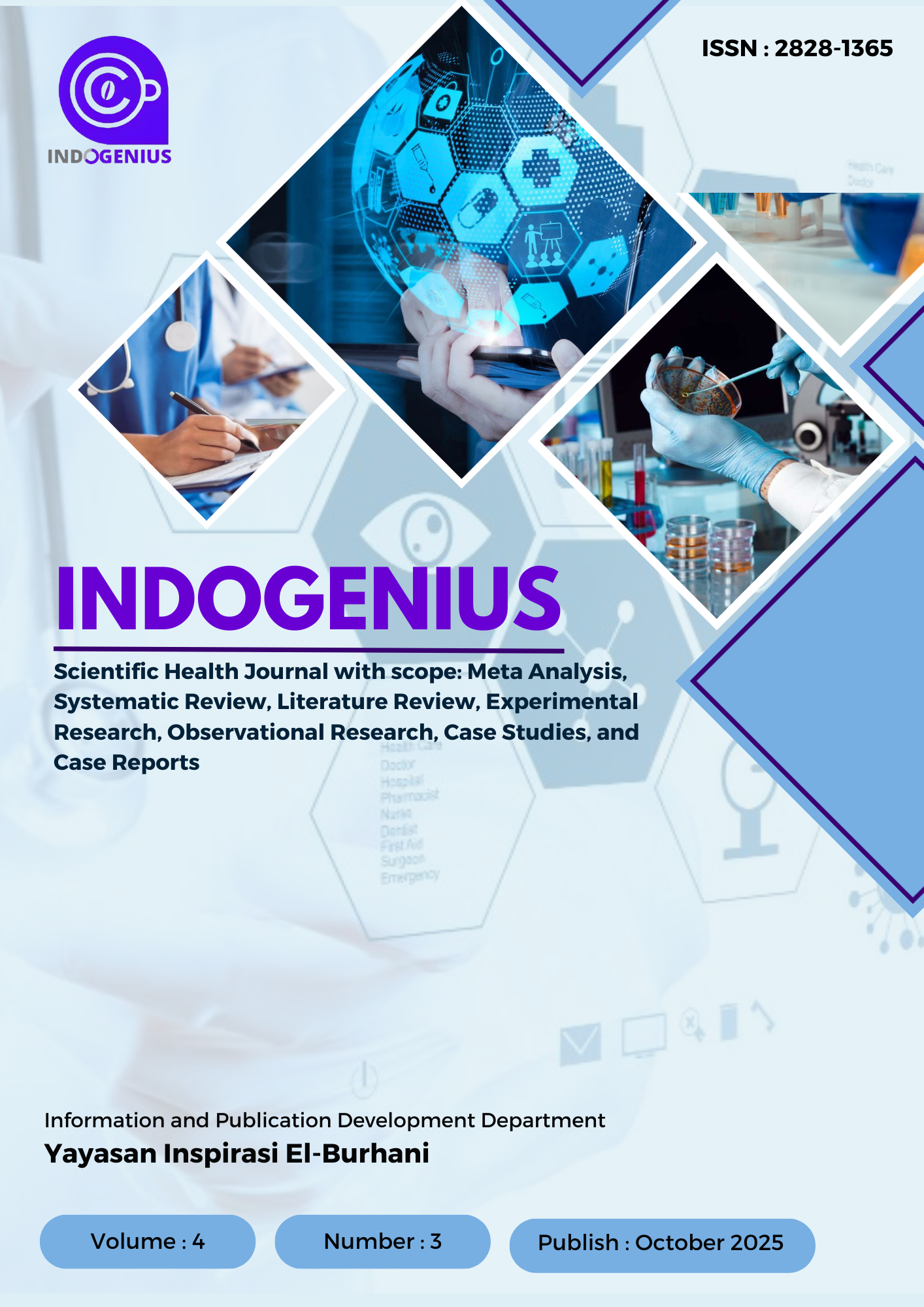Profile of Urine Sediment Examination Results Among Tailors in Sidorejo Village, Comal Subdistrict, Pemalang Regency
DOI:
https://doi.org/10.56359/igj.v4i3.640Keywords:
Microscopic, Sewing machine, Urine sedimentAbstract
Background & Objective: Urine sediment examination is used to detect abnormalities in the kidneys and urinary tract, as well as the severity of disease. Morning urine is preferred because it contains a higher concentration of sediments. For workers engaged in prolonged static activities, such as tailors, this test is important to identify potential health risks associated with occupational habits and unhealthy environments. Tailoring requires sitting for long periods to meet customer demands, increasing the risk of urinary tract stones (urolithiasis). This study aimed to describe the results of urine sediment examination among tailors in Sidorejo Village, Comal Subdistrict, Pemalang Regency.
Method: This descriptive study employed purposive sampling, with 30 respondents providing urine samples for sediment analysis.
Result: Of the 30 urine samples, 2 showed erythrocytes, 2 showed leukocytes, 27 showed squamous epithelial cells, 9 showed transitional epithelial cells, 14 showed calcium oxalate crystals, and 12 showed uric acid crystals.
Conclusion: Urine sediment examination among tailors in Sidorejo Village revealed the presence of erythrocytes, leukocytes, squamous epithelial cells, transitional epithelial cells, calcium oxalate crystals, and uric acid crystals. This highlights the importance of regular urine sediment testing for workers with static activities such as tailoring, as it may help in the early detection of potential health problems caused by occupational habits and poor working conditions.
Downloads
References
, K.R.H.R.K.D.T. (2018) ‘kementrian kesehatan RI.2018’, Journal of Food and Nutrition Research, 2(12), pp. 1029–1036. Available at: https://doi.org/10.12691/jfnr-2-12-26.
Ardianzah (2017) Bahaya menahan buang air kecil bagi kandung kemih. Biosains.
Budi Fristiani, A.K. and Anggraini, H. (2022) ‘Gambaran Leukosit Dan Protein Urin Pada Penderita Gejala Infeksi Saluran Kemih’, Jurnal Labora Medika, 6(2), p. 29. Available at: https://doi.org/10.26714/jlabmed.6.2.2022.29-32.
Damayanti, K.Y., Parwati, P.A. and Abadi, M.F. (2020) ‘Pengaruh Volume Presipitat Urine Terhadap Hasil Pemeriksaan Sedimen Urine’, Journal of Indonesian Medical Laboratory and Science (JoIMedLabS), 1(1), pp. 66–75. Available at: https://doi.org/10.53699/joimedlabs.v1i1.5.
Farizal, J. (2018) ‘Hubungan Kebiasaan Lama Duduk Terhadap Proses Terbentuknya Kristal Urin Pada Penjahit Di Wilayah Kota Bengkulu’, Journal of Nursing and Public Health, 6(1), pp. 36–40. Available at: https://doi.org/10.37676/jnph.v6i1.493.
Kumala, I., Triswanti, N. and , Hidayat, R.L.T. (2021) ‘Gambaran Hasil Pemeriksaan Urinalisis Pada Pasien Infeksi Saluran Kemih Yang Terpasang Kateter’, Jurnal Medika Malahayati, 7(1), pp. 1–23.
Lase, D.M., Tarigan, R.V.B. and Situmorang, P.R. (2023) ‘Analisis Jumlah Leukosit Dan Eritrosit Pada Urine Lengkap Pasien Infeksi Saluran Kemih (Isk) Di Rumah Sakit Santa Elisabeth Medan Tahun 2023’, Journal of Indonesian Medical Laboratory and Science (JoIMedLabS), 4(2), pp. 95–103. Available at: https://doi.org/10.53699/joimedlabs.v4i2.153.
MARLINI, N.M.R.D. (2018) ‘gambaran sedimen urin pada sopir bus diterminal mengwi kabupaten badung’, Nucleic Acids Research, 6(1), pp. 1–7. Available at: http://dx.doi.org/10.1016/j.gde.2016.09.008%0Ahttp://dx.doi.org/10.1007/s00412-015-0543-8%0Ahttp://dx.doi.org/10.1038/nature08473%0Ahttp://dx.doi.org/10.1016/j.jmb.2009.01.007%0Ahttp://dx.doi.org/10.1016/j.jmb.2012.10.008%0Ahttp://dx.doi.org/10.1038/s4159.
Muammar et al. (2020) ‘Pengaruh Konsumsi Sayur Tinggi Oksalat terhadap Terjadinya Batu Saluran Kemih di Rumah Sakit Umum Daerah Zainoel Abidin Banda Aceh’, Jurnal Kedokteran Nanggroe Medika, 3(2), pp. 1–6.
Noviyanti (2015) ‘Hubungan pola makan dengan kadar asam urat di desa kalongan kecamatan kalawat’.
Riskesdas (2018) Dinas Kesehatan Provinsi Jawa Tengah. (2019). Laporan Riskesdas 2018 Kementrian Kesehatan Jawa Tengah Republik Indonesia, Laporan Nasional Riskesdas 2018.
Riswanto, R. (2015) Menerjemahkan Pesan Klinis Urine. 1st edn. Yogyakarta: Pustaka Rasmedia.
Rizkiana, R. (2017) ‘gambaran urinalisa pada penjahit’, 11(1), pp. 92–105.
Rosida, A. and Pratiwi, ewi I.N. (2019) Pemeriksaan Laboratorium Sistem Uropoetik PK UNLAM. Sari Mulia Indah.
Silalahi, M.K. (2020) ‘Faktor-Faktor yang Berhubungan Dengan Kejadian Penyakit Batu Saluran Kemih Pada di Poli Urologi RSAU dr. Esnawan Antariksa’, Jurnal Ilmiah Kesehatan, 12(2), pp. 205–212. Available at: https://doi.org/10.37012/jik.v12i2.385.
Sugiyono (2018) Metode Penelitian Kuantitatif Kualitatif dan R&D.
Widyastuti, R., Tunjung, E. and Purwaningsih, nur vita (2018) ‘Modul praktikum urinalisis dan cairan tubuh’, Universitas Muhammadiya Surabaya, pp. 1–68.
Downloads
Published
How to Cite
Issue
Section
License
Copyright (c) 2025 Silviana Juliyanti, Agus Riyanto

This work is licensed under a Creative Commons Attribution 4.0 International License.

















